
 |
State Spending Plan for 1996-97 |
Continued economic expansion and state General Fund
revenue growth resulted in a major improvement in the state's
budget outlook over the past year. The 1996-97 budget, signed into law
by Governor Wilson on July 15, 1996, substantially increases
funding for education, includes a bank and corporation tax rate
reduction, and provides for a balanced budget at the close of the fiscal year.
At the same time, the new budget continues several funding
reductions made in past years, mostly to health and welfare programs.
The 1996 Budget Act, along with related implementing
legislation, comprise a budget package authorizing $59.8 billion in total
state spending (budget-basis accounting), of which $47.3 billion is
from the General Fund and $12.6 billion is from special funds.
Major features of the state budget include:
Since the state budget was passed, the President signed a
federal welfare measure which will have significant implications in
1996-97, and potentially major effects in future years.
The budget package signed by the Governor in July
authorizes total state spending of $59.8 billion in 1996-97, of which
$47.3 billion is from the General Fund and $12.6 billion is from
special funds (budgetary accounting basis). The General Fund
condition under the plan is depicted in Figure 2, which shows that
revenues are projected to grow by 3.3 percent in 1996-97, while
expenditures are projected to grow by 4 percent. Under the plan,
the General Fund would end 1996-97 with a reserve of
slightly over $300 million.
In the remainder of this chapter, we discuss the challenges
and key developments associated with arriving at the new
state budget, and provide a brief overview of the 1996-97
spending plan itself. Chapter 2 provides information on aggregate
spending levels in the new budget, as well as a longer-term
historical perspective on state expenditure trends. Chapter 3 discusses
in more detail the major specific features of the new budget,
by major program area.
The figure shows that revenues were growing modestly in
1989-90. They then fell during the early 1990s' recession, grew very
modestly for a couple of years, and then rebounded strongly in both
1994-95 and 1995-96. Based on current projections, revenues will continue
to grow at a moderate pace in 1996-97, resulting in the strongest
three-year revenue growth (1994-95 through 1996-97) since the mid-1980s.
Proposition 98 Versus Non-Proposition 98
Spending. Within the overall General Fund budget, however, there was a
sharp
contrast between the funding outlook for K-14 education under
Proposition 98, versus that for
non-Proposition 98 program funding.
Given the above, the central challenge facing policymakers as
they approached developing the 1996-97 budget was twofold how
to allocate the new Proposition 98 resources expected to be
available for education, and how to allocate the non-Proposition 98 portion
of the budget among the many spending areas competing for the
scarce resources available.
The Governor's January budget proposal was dependent
on federal actions to achieve approximately $2.6 billion in
state budget savings, mostly in the health and welfare program areas.
On the expenditure side, K-14 spending increased by
$1.9 billion over the two years in the May Revision, primarily reflecting
the impact of higher revenues on the Proposition 98 minimum
funding guarantee. The Governor proposed to spend these funds on
a variety of new education-related initiatives, including
class-size reduction.
The May Revision also included a net of $800 million in
new expenditures in other program areas. The majority was for
health and welfare expenditures needed to "backfill" savings that
were dependent on federal actions which did not occur. To keep
the budget in balance, the Governor also proposed new
reductions, including a 3.4 percent cut in Supplemental Security
Income/State Supplementary Program (SSI/SSP) grants.
Aside from these major changes, the Governor's May
Revision retained most of the same priorities as the original January
proposal, including the 15 percent income tax rate reduction.
The Senate version of the budget, however, contained
numerous differences from the Governor's original proposal. It rejected
the Governor's tax cut proposal, as well as the proposal to extend
certain existing and all new AFDC and SSI/SSP grant reductions. It
also rejected the Governor's proposed income tax "check-off" for
local public safety, and it reduced corrections' funding. Finally, the
Senate version funded the Renters' Tax Credit.
Comparison Between Final Budget and May
Revision. The final budget package contains both similarities and differences
from the May Revision. Revenues were adjusted upward slightly,
by $34 million. On the expenditure side, key similarities
included major increases in K-12 education, full funding for
corrections, and growth in funding for higher education sufficient to
avoid student fee increases. Likewise, there was no general
salary increase for state employees. Key differences (or
modifications) included the adoption of a 5 percent bank and corporation
tax rate reduction, the absence of new cuts to welfare grant
levels, and a more limited extension of certain past welfare savings.
The final budget also extended the suspension of the Renters'
Tax Credit for one year, rather than permanently eliminating
the credit, as was proposed in the May Revision. Finally, the
final budget included a subvention of funds to local governments
for public safety purposes, in lieu of the income tax
"checkoff" program originally proposed for similar purposes.
The Legislature also convened a Conference Committee to
consider a variety of tax measures with the intent of enacting a
revenue-neutral measure which would aid small businesses in
California. Senate Bill 38, which was passed in late August, includes an
increase in the research and development tax credit and a variety of
other provisions, some of which involve conformity to federal tax
law. These measures are described more fully in Chapter 3. Senate Bill
38, signed into law in late September, is projected to result in a
$10 million revenue reduction in 1996-97, and a combined revenue
reduction of $80 million during its first three years.
Health and Welfare. The budget extends or makes permanent
past grant reductions in the state's AFDC and SSI/SSP programs,
but does not adopt new cuts. Specifically, it makes the 1992-93
welfare grant reductions permanent and extends the statewide
199596 grant reduction through October 1997. The budget suspends
state cost-of-living adjustments (COLAs) for AFDC and
SSI/SSP through October 1997. However, it does provide the full
federal SSI COLA to recipients.
With regard to the state's health programs, the budget expands
teen pregnancy prevention programs and extends the Medi-Cal
Supplemental Drug Rebate Program until January 1, 1997, after
which rebates could be negotiated with individual manufacturers.
Higher Education. The budget includes significant funding
increases for the University of California and California State University,
with no student fee increases.
Corrections. The budget includes close to full funding for
corrections. It contains no policy changes and no funding for new
prisons. The budget includes some reductions for caseload adjustments
and administrative costs relative to the Governor's budget proposal.
Local Government. In lieu of the Governor's proposed income
tax "checkoff" for local public safety, the budget provides a
direct appropriation of $100 million for local law enforcement and
$50 million to the Board of Corrections for juvenile justice grants.
The budget also assumed the adoption of the Governor's
proposed changes to trial court funding, which would reduce both
General Fund expenditures and revenues by $3 billion in 1996-97.
However, implementing legislation was not enacted.
Renters' Tax Credit. The budget extends the suspension of
the Renters' Tax Credit for 1996. The Governor had proposed
elimination of the credit.
The remainder of the federal actions are primarily related to (1)
new federal reimbursements for state costs of providing
emergency Medi-Cal services to undocumented immigrants ($216 million)
and (2) the federal adoption of an Internal Revenue Service tax
offset program ($85 million), under which the federal government
would collect for California delinquent state taxes out of the refunds
owed to Californians on their federal income tax returns.
Welfare Reform. This measure will have a variety of state-level
fiscal impactsespecially in future years. With regard to the estimates
in Figure 7, the federal welfare measure has two implications:
More generally, the federal welfare reform measure could result
in either cost increases or decreases in state welfare programs
during 1996-97, depending on how it is implemented in California.
These potential effects are not likely to be major in the current
year. However, they could become substantial in the future. Some of
the federal measure's potential effects on state spending are
addressed in Chapter 3 of this report.
Federal Budget. Although funding was
authorized in federal immigration reform legislation for Medi-Cal services to
undocumented persons, the 1997 federal budget does not
appropriate any of the additional federal funds assumed in the state's budget
for this purpose.
Internal Revenue Service Offset. The main vehicle for the
federal offset legislation (HR 757) was pending in the House Ways
and Means Committee. However, it was not passed out of
committee before Congress adjourned.
Continue to Chapter 2 - State Expenditures -Dollar
Amounts and Trends Over Time
Summary
Chapter 1
The 1996-97 Budget Package
Introduction and Overview
Three years of moderate economic expansion and reasonably
strong revenue growth have produced a significant improvement in
the near-term fiscal outlook for California. The revenue gains
enabled the Legislature and Governor to adopt a 199697 budget plan
which eliminates the accumulated budget deficit carried over from
the recessionary years, provides major funding increases for K-14
education, and includes a 5 percent reduction in the bank and
corporation tax rate, as shown in Figure 1. At the same time, the new
budget does incorporate several important policy and fiscal tradeoffs,
including the extension of temporary welfare grant reductions
made in past years, as well as an additional one-year suspension of
the renters' tax credit.
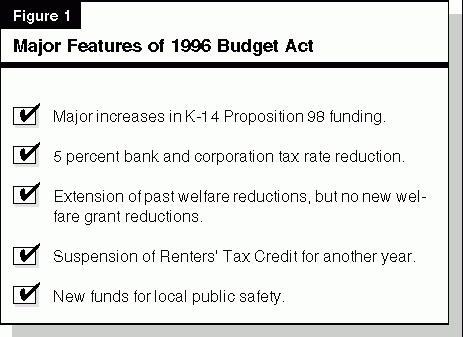

State Revenue Gains
As indicated above, a key factor behind the improvement in
the state's fiscal picture has been the healthy growth in General
Fund revenues. The extent of this improvement is depicted in
Figure 3, which shows the year-to-year percent change over the past
seven years in underlying revenues (that is, revenues adjusted to
eliminate the effects of revenue-related law changes adopted in the 1990s).
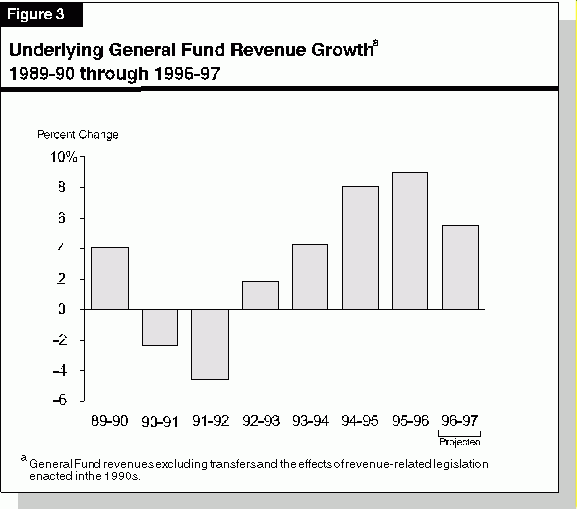
1996-97 Budget Challenges
Partly as a result of the revenue improvement, the fiscal
circumstances surrounding the development of the 1996 Budget Act
were the most positive of the past five years. In contrast to the
previous climate of weak revenue growth and major budget shortfalls,
the Legislature was able to allocate increased
funds among new programs and provide tax relief, while at the same time being able
to balance the budget.
Development of the Budget
In this section, we provide a brief chronology of the development
of the 1996-97 budget, which began with the introduction of
the Governor's initial budget proposal in early January 1996, and
concluded with the enactment of the budget package in early July.
The Governor's January Proposal
The Governor's January budget proposal for 1996-97
contained many of the same priorities as his original proposal for 1995-96.
It included a 15 percent cut in personal and corporate income tax
rates phased in over three years, and modest increases in K14
education funding consistent with the requirements of Proposition 98.
The Governor's proposal addressed the tightness in the
non-Proposition 98 portion of the budget primarily by making permanent
both the elimination of the Renters' Tax Credit and past
temporary welfare reductions. It also targeted health and welfare programs
for new reductions, including a 4.5 percent cut in grant levels for Aid
to Families with Dependent Children (AFDC). These proposed
reductions were partly offset by new health and welfare initiatives in
the areas of family planning and teen pregnancy prevention, as well
as an income tax "check-off" to provide funds for local law
enforcement. The proposal also included funds for the state to "buy
out" student fee increases for higher education in 1996-97. Finally,
the budget included full funding for criminal justice programs,
and contained a proposal for a significant restructuring of the trial
court program. The budget proposal did not include a general
salary increase for state employees.
The May Revision
The May Revision to the Governor's 1996-97 budget
proposal reflected a major increase in both revenues and
expenditures. On the revenue side, the administration raised its forecast
by $1.2 billion for 199596 and $1.6 billion for 1996-97 (after
adjusting for changes in the estimated cost of the tax cut
proposal), or approximately $2.7 billion for the two years
combined (see Figure 4). When combined with a prior-year
upward revision of $100 million, the three-year increase in
revenues totaled about $2.8 billion.
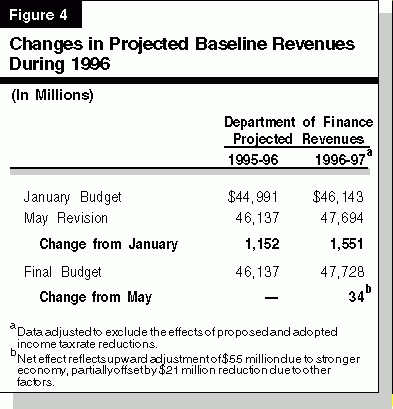
Legislative Actions
The version of the budget passed by the Assembly in late
May contained most of the Governor's key May Revision
proposals, including the tax cut, the welfare reductions (except for the
3.4 percent SSI/SSP grant reductions), increased funding for higher
education, and full funding for corrections.
Final Budget
The Assembly and Senate versions of the budget were sent
to Conference Committee for reconciliation in early June.
Following four weeks of negotiations, the Conference Committee passed
a budget which was approved by both houses of the Legislature
on July 8, 1996. Before signing the bill, the Governor vetoed $80 million
in General Fund expenditures and $2 million in special funds
expenditures, eliminating some legislative augmentations for capital outlay.
Major Features of 1996-97 Budget Act
Key features of the 1996-97 budget include a bank and
corporation tax cut, major funding increases for K-14 education, and
reductions in non-Proposition 98 programs.
Tax Reduction
The budget package provides for a 5 percent reduction in the bank
and corporation tax rate, from 9.3 percent to 8.84 percent, effective
for income years beginning on or after January 1, 1997. This tax cut is in
lieu of the Governor's proposal for a phased 15 percent reduction in
both personal and corporation income tax rates. The enacted tax cut
is projected to reduce revenues by $85 million in 1996-97, growing
to $290 million when fully implemented in 1998-99.
Proposition 98 Spending
As indicated above, the major upward adjustments in revenues
in 1995-96 and 1996-97 enabled the Governor and the Legislature
to provide significant increases in K-12 per pupil funding in
both years. The budget spends Proposition 98 funds on a variety of
new initiatives, including class-size reduction in grades K-3 ($771 million
in 1996-97), one-time block grants ($587 million), and portable facilities
to accommodate class-size reductions ($200 million). The budget
also includes significant funding increases for the community colleges
along with no student fee increases.
Non-Proposition 98 Programs
Figure 5 (next page) summarizes the major budgetary
actions affecting the non-Proposition 98 share of the budget. In
contrast to the increases in Proposition 98 funding, the
non-Proposition 98 portion of the budget includes significant reductions relative
to prior-law spending requirements. As shown in Figure 5,
the majority of the savings that were adopted in the budget related
to the extension of past temporary grant reductions in the
state's welfare programs and the continued suspension of the
Renters' Tax Credit. Partly offsetting these savings were new initiatives
in local law enforcement, family planning and teen pregnancy
prevention, as well as new funds for the General Fund "buyout"
of higher education student fee increases.
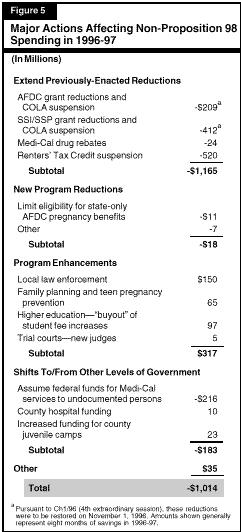
The Budget "Trailer Bills"
In addition to the 1996 Budget Act, the 1996-97 budget package
includes several related measures enacted to implement and carry out
the budget's provisions. Figure 6 lists these budget "trailer bills."
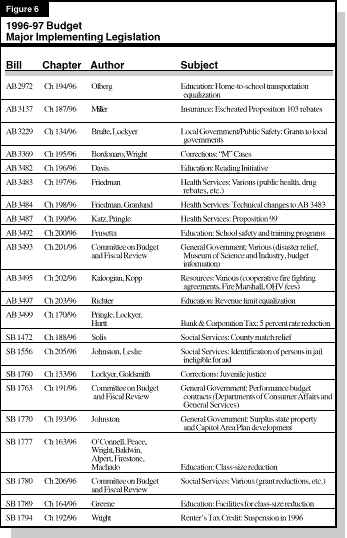
Savings That Depend on Federal Actions
Figure 7 shows that the budget relies on federal actions to
achieve $731 million in savings, mostly in health and welfare programs.
Of this total, $430 million is related to the elimination of federal
maintenance-of-effort (MOE) requirements, which would allow
California to implement previously enacted reductions to AFDC and
SSI/SSP grant levels. The budget assumes that federal actions would
be taken by August 1996 which would permit a reduction in
AFDC grants effective in October 1996, and a reduction in SSI/SSP
grants effective in November 1996. The main vehicle for state MOE relief
has been the federal welfare reform measure, which was pending
in Congress when the state budget was passed in July, but has
since been passed.
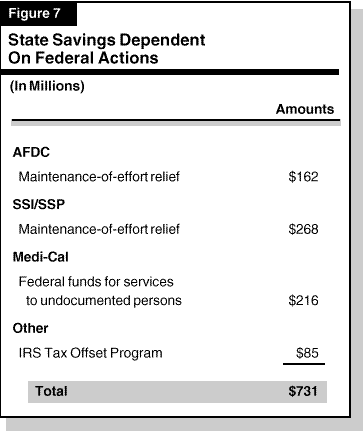
Status of Federal Actions
Since the state budget was passed, Congress has passed and
the President has signed measures enacting federal welfare reform
and the 1997 federal budget. Based on these and related actions, most
of the savings listed in Figure 7 will not be realized.